Vegetable lasagna is the perfect way to enjoy a nutritious yet indulgent meal packed with layers of roasted vegetables, creamy ricotta, rich marinara sauce, and melted cheese. Whether you’re a vegetarian or simply looking for a lighter alternative to traditional lasagna, this dish delivers all the comforting flavors of a classic pasta bake without the heaviness of meat.
In this guide, we’ll cover everything you need to know about making the best vegetable lasagna—from choosing the right vegetables and cheese to layering and baking it to perfection. Whether you prefer a classic version, a vegan-friendly alternative, or a gluten-free option, this recipe is easy to customize for any dietary preference.
What is Vegetable Lasagna?
A Healthier Take on a Classic Dish
Unlike traditional lasagna, which is typically made with ground beef or sausage, this version is loaded with fresh vegetables like zucchini, spinach, bell peppers, and mushrooms. These ingredients not only enhance the flavor but also add fiber, vitamins, and minerals, making it a well-balanced meal.
This recipe is perfect for:
- Vegetarians or those reducing meat intake
- Families looking for a wholesome, home-cooked meal
- Anyone who enjoys cheesy, baked pasta dishes
Why Make a Meatless Lasagna?
There are several benefits to choosing vegetable lasagna over the traditional kind:
✔ More nutrients – Packed with fiber, vitamins, and antioxidants.
✔ Lighter yet filling – A great balance of indulgence and health.
✔ Versatile and customizable – Easily adapted for vegan or gluten-free diets.
Unlike classic versions that rely on rich meat sauces, this dish is light yet packed with flavor, making it a fantastic way to enjoy a comforting meal with a nutritious twist.
Ingredients for the Best Vegetable Lasagna
Making vegetable lasagna starts with selecting fresh, high-quality ingredients that add rich flavors and the perfect texture. From the best vegetables to the ideal cheese and sauce, here’s everything you need for a delicious and hearty meatless lasagna.
Essential Ingredients for a Flavorful Dish
A well-balanced vegetable lasagna includes layers of vegetables, creamy cheese, and a savory sauce. Here are the must-have ingredients:
1. Vegetables (The Star of the Dish)
The key to a great meatless lasagna is choosing the right vegetables that provide texture, flavor, and nutrients.
Best Vegetables to Use:
- Zucchini – Adds a mild, slightly sweet flavor and softens beautifully when baked.
- Spinach – Brings freshness and pairs well with cheese.
- Mushrooms – Adds a deep, umami flavor that makes the dish heartier.
- Bell Peppers – Provides a subtle sweetness and crunch.
- Carrots – Slightly sweet and enhances the sauce’s depth.
- Eggplant – A great substitute for pasta layers in a low-carb version.
- Onions & Garlic – Essential for flavor in the sauce and sautéed vegetables.
🔹 Tip: Roasting or sautéing vegetables beforehand removes excess moisture and enhances their natural sweetness.
2. Cheese Selection for Creamy Layers
Cheese is what makes vegetable lasagna so rich and satisfying.
Best Cheese Combinations:
- Ricotta Cheese – The classic choice for a creamy texture.
- Mozzarella Cheese – Provides the gooey, melty factor.
- Parmesan Cheese – Adds a sharp, nutty taste and enhances the overall flavor.
- Cottage Cheese (Alternative to Ricotta) – A lighter option with extra protein.
- Vegan Cheese (For Dairy-Free Version) – Choose plant-based mozzarella or cashew ricotta.
🔹 Tip: Mixing mozzarella and Parmesan creates the perfect golden-brown topping.
3. Best Sauces for Vegetable Lasagna
A rich and flavorful sauce is the foundation of a great lasagna.
Top Sauce Options:
- Classic Marinara Sauce – The traditional tomato-based choice.
- Alfredo Sauce – For a creamy, indulgent version.
- Pesto Sauce – Adds a fresh, herby twist.
- Spicy Arrabbiata Sauce – Gives a little heat for added depth.
🔹 Tip: Avoid watery sauces to prevent a soggy lasagna—cook down the sauce slightly before layering.
4. Pasta Options for Layering
- Regular Lasagna Noodles – Works best when pre-cooked or no-boil versions are used.
- Whole Wheat Lasagna Noodles – A healthier option with more fiber.
- Gluten-Free Lasagna Noodles – Perfect for those avoiding gluten.
- Zucchini or Eggplant Slices (Low-Carb Option) – Works as a pasta substitute.
🔹 Tip: If using fresh veggies like zucchini as noodles, salt them and let them sit for 10 minutes to draw out excess moisture.
Step-by-Step Guide to Making Vegetable Lasagna
Now that you have all the essential ingredients, it’s time to put everything together! Follow this step-by-step guide to ensure your vegetable lasagna is layered correctly, baked to perfection, and full of flavor.
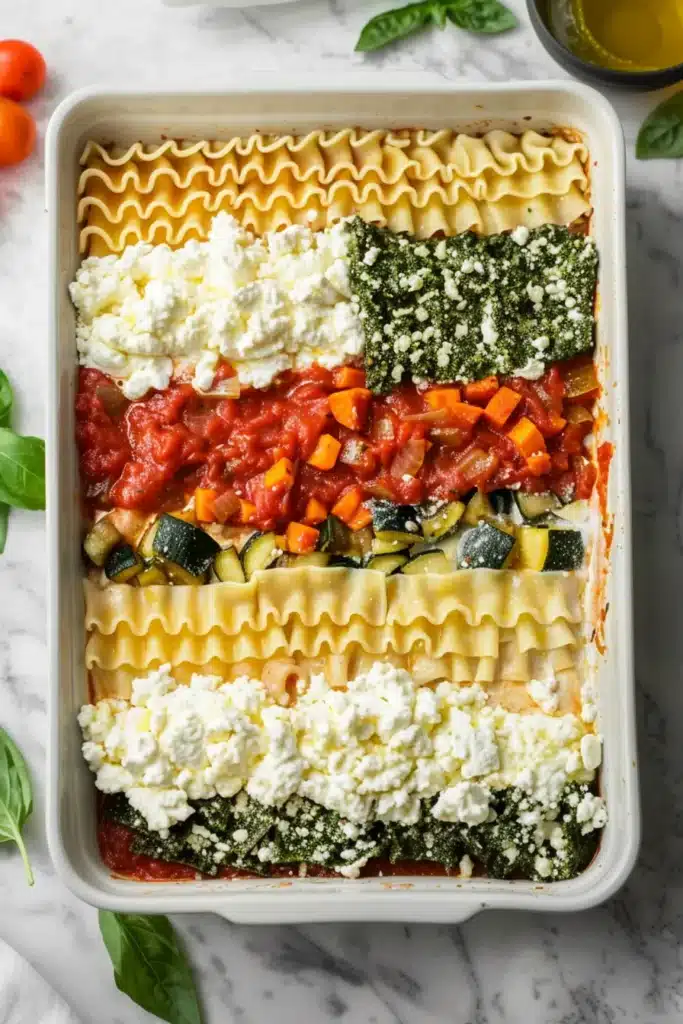
How to Layer Vegetable Lasagna Properl
Step 1: Prepare the Vegetables
Before assembling your lasagna, make sure your vegetables are properly prepped:
- Sauté spinach, mushrooms, onions, and garlic in olive oil for enhanced flavor.
- Roast zucchini, eggplant, and bell peppers at 400°F (200°C) for 15 minutes to remove excess moisture.
- Grate or finely chop carrots so they blend well into the layers.
🔹 Tip: Cooking the vegetables before layering prevents a watery lasagna.
Step 2: Cook the Lasagna Noodles (If Needed)
- If using no-boil noodles, they can go straight into the dish.
- If using regular lasagna noodles, cook them two minutes less than package instructions for a firmer texture.
- For a gluten-free or low-carb version, use zucchini or eggplant slices as a pasta alternative.
Step 3: Assemble the Lasagna
Use a 9×13-inch baking dish and layer your ingredients as follows:
- Spread a thin layer of sauce on the bottom of the dish to prevent sticking.
- Place the first layer of noodles (or vegetable slices for a low-carb option).
- Add a layer of sautéed or roasted vegetables, evenly distributed.
- Dollop ricotta cheese mixture and spread it gently.
- Sprinkle mozzarella and Parmesan cheese over the layer.
- Repeat layers (sauce → noodles → veggies → cheese) until you reach the top.
- Finish with a final layer of noodles, sauce, and extra cheese for a golden-brown crust.
🔹 Tip: Press down gently on each layer to remove air pockets and ensure even cooking.
Step 4: Bake to Perfection
- Preheat oven to 375°F (190°C).
- Cover the baking dish with foil and bake for 30 minutes to allow the flavors to meld.
- Remove the foil and bake for 10-15 more minutes until the cheese is bubbly and golden brown.
- Let the lasagna rest for 10 minutes before slicing to help the layers set.
🔹 Tip: If you like a crispy cheese top, broil the lasagna for 2-3 minutes at the end.
Common Mistakes to Avoid
- Skipping pre-cooking vegetables – This leads to a watery lasagna.
- Overloading with sauce – Too much sauce can make the dish soggy.
- Not resting before cutting – Slicing too soon will cause the layers to fall apart.
“If you love comforting, slow-cooked flavors, discover how to make Slow Cooker Lasagna Soup, a cozy twist on traditional lasagna.”
Vegetable Lasagna Variations to Try
One of the best things about vegetable lasagna is how versatile it is. Whether you’re following a specific diet or simply want to experiment with different flavors, here are some delicious variations to try.
Vegan Vegetable Lasagna (Dairy-Free Option)
For a completely plant-based version, replace the dairy ingredients with vegan alternatives.
Key Substitutions:
- Ricotta Cheese → Cashew Ricotta (Blend soaked cashews with lemon juice, garlic, and nutritional yeast)
- Mozzarella Cheese → Dairy-Free Mozzarella (Choose a plant-based melting cheese)
- Parmesan Cheese → Nutritional Yeast (Adds a savory, cheesy flavor)
- Egg in Ricotta → Silken Tofu or Flax Egg (Helps with binding)
How to Make It:
- Follow the same layering process, replacing the dairy cheeses with vegan options.
- Use a dairy-free white sauce or marinara instead of Alfredo.
- Bake as usual, ensuring the cheese melts properly.
Gluten-Free Vegetable Lasagna
For those avoiding gluten, swap traditional pasta for gluten-free alternatives.
Best Pasta Substitutes:
- Gluten-Free Lasagna Noodles (Available in most stores)
- Zucchini Slices (Thinly sliced lengthwise)
- Eggplant Slices (Lightly roasted for better texture)
How to Make It:
- If using vegetable slices instead of noodles, lightly salt them and let them sit for 10 minutes to remove excess moisture.
- Follow the standard layering method, ensuring each layer is spread evenly to prevent excess liquid.
Low-Carb Zucchini Noodle Lasagna
For a lighter version, replace pasta entirely with thinly sliced zucchini.
Key Adjustments:
- Use zucchini slices instead of lasagna noodles
- Reduce sauce to prevent excess moisture
- Increase cheese layers to hold the structure together
How to Make It:
- Slice zucchini thinly and roast or grill before layering to remove excess water.
- Layer as usual, using less sauce to prevent a watery dish.
- Bake slightly longer to ensure a firm texture.
“Looking for an easy, hands-off version? Try this Easy Crockpot Lasagna Recipe, perfect for busy weeknights.”
Best Sauces for Vegetable Lasagna
The sauce you choose for vegetable lasagna can completely transform the dish. Whether you prefer a classic tomato-based sauce, a creamy alternative, or something with a little spice, the right sauce enhances the flavors and textures. Here are some of the best options to consider.
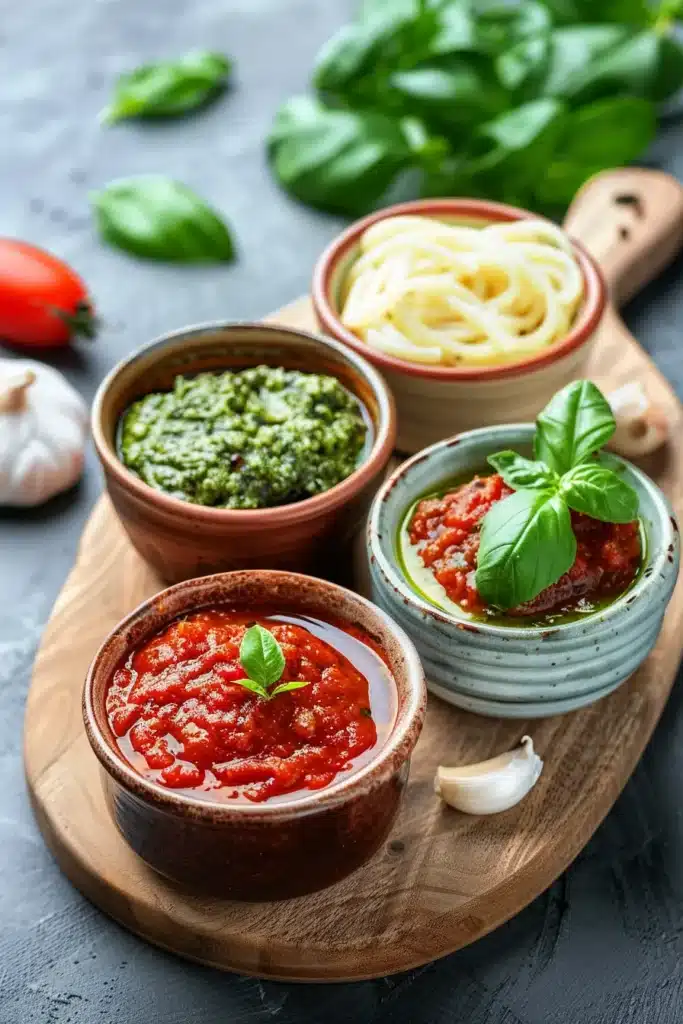
Classic Marinara Sauce (Traditional Choice)
Best for: Traditional vegetable lasagna with a rich, tangy tomato flavor.
Marinara sauce is the go-to option for lasagna. It’s made with tomatoes, garlic, onions, and Italian herbs, creating a savory and slightly sweet balance. Homemade marinara works best, but high-quality store-bought versions can also deliver great flavor.
Quick Homemade Marinara Recipe:
- Sauté garlic and onions in olive oil.
- Add crushed tomatoes, basil, oregano, salt, and pepper.
- Simmer for 15-20 minutes to enhance the flavors.
Alfredo Sauce (Creamy & Indulgent)
Best for: White vegetable lasagna with a rich, cheesy texture.
For a creamy alternative, Alfredo sauce is a great choice. It pairs especially well with spinach, mushrooms, and zucchini.
Quick Homemade Alfredo Recipe:
- Melt butter in a pan, then add minced garlic.
- Pour in heavy cream and let it simmer.
- Stir in Parmesan cheese and whisk until smooth.
For a lighter version, use Greek yogurt or cashew cream as a base.
Pesto Sauce (Fresh & Herby Twist)
Best for: Adding a fresh and aromatic flavor to vegetable lasagna.
Pesto is made from fresh basil, garlic, pine nuts, Parmesan, and olive oil. It’s perfect for those who want a unique, herbaceous twist.
How to Use It:
- Mix with ricotta cheese for a flavorful filling.
- Drizzle on top of baked lasagna for extra freshness.
- Blend with Alfredo sauce for a creamy pesto variation.
Spicy Arrabbiata Sauce (For Extra Heat)
Best for: Those who enjoy a little spice in their lasagna.
Arrabbiata sauce is similar to marinara but with red pepper flakes added for extra heat.
How to Make It Spicy:
- Follow the marinara recipe, adding 1-2 teaspoons of red pepper flakes.
- Simmer for 15-20 minutes to absorb the spice evenly.
Roasted Red Pepper Sauce (Sweet & Smoky Option)
Best for: A unique alternative to traditional tomato sauces.
Roasted red peppers bring a slightly smoky and sweet flavor that pairs well with grilled vegetables.
How to Make It:
- Blend roasted red bell peppers, olive oil, garlic, and a splash of balsamic vinegar until smooth.
- Use as a sauce layer or mix with ricotta for a different flavor.
What to Serve with Vegetable Lasagna
Vegetable lasagna is a hearty and flavorful dish, but pairing it with the right sides can enhance the meal by adding texture, freshness, or complementary flavors. Whether you want something light and refreshing or rich and indulgent, here are the best side dishes to serve.

1. Fresh Salads for a Light Balance
A crisp salad adds a refreshing contrast to the cheesy and saucy layers of vegetable lasagna.
- Classic Caesar Salad – Romaine lettuce, Parmesan cheese, croutons, and creamy Caesar dressing.
- Italian Chopped Salad – A mix of cucumbers, cherry tomatoes, red onions, olives, and Italian vinaigrette.
- Arugula Salad with Lemon Dressing – Peppery arugula with fresh lemon juice and shaved Parmesan.
For extra flavor, add balsamic glaze or fresh mozzarella.
2. Garlic Bread – The Perfect Sidekick
Garlic bread complements vegetable lasagna by adding a crispy, buttery contrast.
- Classic Garlic Bread – Toasted baguette slices brushed with garlic butter.
- Cheesy Garlic Bread – Topped with mozzarella or Parmesan for extra richness.
- Garlic Knots – Soft, bite-sized knots coated in garlic and herbs.
Dipping garlic bread in marinara sauce makes it even better.
3. Roasted Vegetables for Extra Nutrition
If you want to keep the meal veggie-focused, roasted vegetables are a great side dish.
- Oven-Roasted Brussels Sprouts – Tossed with olive oil and balsamic glaze.
- Garlic Butter Mushrooms – Sautéed with garlic, butter, and parsley.
- Roasted Broccoli and Cauliflower – Lightly seasoned with lemon zest and Parmesan.
Adding a sprinkle of red pepper flakes or a drizzle of lemon juice enhances their flavor.
4. Italian-Inspired Appetizers
For a dinner party or special occasion, these appetizers pair well with vegetable lasagna.
- Bruschetta – Toasted bread topped with diced tomatoes, garlic, basil, and olive oil.
- Antipasto Platter – A selection of Italian meats, cheeses, olives, and marinated vegetables.
- Stuffed Mushrooms – Filled with ricotta, herbs, and breadcrumbs.
Pairing these with a glass of red wine, like Chianti or Sangiovese, can complete an Italian-inspired meal.
5. Soups for a Cozy Pairing
A warm bowl of soup can make the meal even more comforting.
- Minestrone Soup – A classic Italian vegetable soup with beans and pasta.
- Tomato Basil Soup – Smooth and creamy, perfect for dipping garlic bread.
- Roasted Red Pepper Soup – A slightly smoky, rich alternative to tomato soup.
For extra texture, add croutons or a sprinkle of Parmesan cheese on top.
“For another delicious lasagna variation, check out this Homemade Chicken Lasagna Recipe, a creamy and protein-packed twist on the classic dish.”
How to Store and Reheat Vegetable Lasagna
If you have leftovers or want to prepare vegetable lasagna ahead of time, proper storage and reheating methods will help maintain its texture and flavor. Here’s how to store it correctly and reheat it without drying out or becoming soggy.
How to Store Leftovers
Refrigerator Storage (Short-Term)
- Let the lasagna cool completely before storing to prevent condensation and sogginess.
- Cover the baking dish tightly with plastic wrap or aluminum foil or transfer portions to an airtight container.
- Store in the refrigerator for up to 4 days.
Freezer Storage (Long-Term)
- For longer storage, freeze the lasagna for up to 3 months.
- Wrap the entire dish tightly with aluminum foil or plastic wrap. If storing individual portions, place them in freezer-safe containers.
- Label with the date to keep track of freshness.
How to Reheat Vegetable Lasagna
Reheating properly ensures the lasagna stays moist and cheesy without drying out.
Oven Method (Best for Maintaining Texture)
- Preheat the oven to 350°F (175°C).
- Place the lasagna in an oven-safe dish and cover with foil to prevent it from drying out.
- Bake for 20-30 minutes or until heated through.
- Remove the foil in the last 5 minutes for a slightly crispy top.
Microwave Method (Faster Option)
- Place a portion on a microwave-safe plate.
- Cover with a damp paper towel to retain moisture.
- Heat on medium power for 2-3 minutes, checking and stirring if needed.
Reheating from Frozen
- If frozen, let the lasagna thaw in the refrigerator overnight before reheating.
- Reheat in the oven at 350°F (175°C) for 40-45 minutes, covering with foil for the first 30 minutes.
- For a quick option, use the microwave in short bursts, stirring between intervals.
Tips for Best Results
✔ Add a small amount of extra sauce before reheating to prevent dryness.
✔ Always cover with foil in the oven to retain moisture.
✔ If using the microwave, stir halfway through to ensure even heating.
FAQs About Vegetable Lasagna
Here are answers to some of the most common questions people have about vegetable lasagna.
What are the best vegetables for lasagna?
The best vegetables for lasagna include zucchini, spinach, mushrooms, bell peppers, carrots, onions, and eggplant. These add flavor, texture, and nutrients. Roasting or sautéing vegetables before layering helps prevent excess moisture.
Can I make vegetable lasagna ahead of time?
Yes, vegetable lasagna is a great make-ahead meal. Assemble it up to 24 hours in advance, cover it tightly with foil or plastic wrap, and store it in the refrigerator. When ready to bake, remove it from the fridge and add 5-10 extra minutes to the baking time.
Do I need to cook the vegetables before layering?
Yes, cooking the vegetables before layering is recommended. Sautéing or roasting them removes excess moisture and enhances their natural sweetness, preventing a watery lasagna.
How do I prevent vegetable lasagna from getting watery?
To avoid a watery lasagna:
Cook the vegetables beforehand to release moisture.
Use a thick sauce instead of a runny one.
Let the lasagna rest for 10 minutes after baking to allow the layers to set.
Can I freeze vegetable lasagna?
Yes, vegetable lasagna freezes well. You can freeze it before or after baking:
Unbaked lasagna: Assemble, wrap tightly, and freeze for up to 3 months. Bake from frozen at 350°F (175°C) for about 1 hour, covering with foil for the first 40 minutes.
Baked lasagna: Cool completely, wrap portions individually, and freeze. Reheat in the oven or microwave when needed.
What cheese works best in vegetable lasagna?
A mix of ricotta, mozzarella, and Parmesan provides the best texture and flavor. Ricotta adds creaminess, mozzarella melts beautifully, and Parmesan enhances the overall taste. For a dairy-free version, use cashew ricotta and vegan mozzarella.
Conclusion and Final Tips
Vegetable lasagna is a delicious and nutritious alternative to traditional lasagna, packed with layers of roasted vegetables, creamy cheese, and flavorful sauce. Whether you prefer a classic version, a vegan-friendly alternative, or a gluten-free option, this dish is incredibly versatile and can be customized to suit any dietary preference.
By following the right layering techniques, choosing the best vegetables and cheese, and using proper storage and reheating methods, you can enjoy a perfectly baked lasagna every time.
Final Tips for the Best Vegetable Lasagna
✔ Pre-cook your vegetables to prevent excess moisture.
✔ Use a thick sauce to avoid a watery lasagna.
✔ Let the lasagna rest for 10 minutes before slicing to maintain structure.
✔ Experiment with different sauces like marinara, Alfredo, or pesto for unique flavors.
✔ Make it ahead of time for a convenient meal prep option.
Vegetable lasagna is the perfect combination of comfort food and wholesome ingredients. Whether you’re serving it for a family dinner or meal prepping for the week, this dish is guaranteed to be a crowd-pleaser. Try it today and enjoy a rich, cheesy, and flavorful meal!
“If you enjoyed this recipe, explore our Homemade Ravioli Lasagna Recipe, another creative and delicious take on classic lasagna.”
“Want more delicious and easy recipes? Follow us on Facebook for daily meal inspiration, cooking tips, and exclusive content!”
Table of Contents
Table of Contents

Vegetable Lasagna – A Cheesy and Healthy Comfort Dish
- Total Time: 1 hour 5 minutes
- Yield: 6 servings 1x
- Diet: Vegetarian
Description
A delicious and hearty vegetable lasagna layered with roasted vegetables, creamy ricotta, rich marinara sauce, and melted cheese, perfect for a comforting meal.
Ingredients
- 12 lasagna noodles (regular or no-boil)
- 2 zucchinis, sliced
- 1 cup spinach, chopped
- 1 cup mushrooms, sliced
- 1 bell pepper, diced
- 1 carrot, grated
- 1 small eggplant, sliced
- 1 onion, chopped
- 3 cloves garlic, minced
- 2 tablespoons olive oil
- 2 cups ricotta cheese
- 1 egg
- 2 cups shredded mozzarella cheese
- 1/2 cup grated Parmesan cheese
- 3 cups marinara sauce
- 1 teaspoon dried oregano
- 1 teaspoon dried basil
- Salt and pepper to taste
Instructions
- Preheat oven to 375°F (190°C).
- In a pan, heat olive oil and sauté onions and garlic until fragrant.
- Add mushrooms, zucchini, bell pepper, carrot, eggplant, and spinach. Cook until softened.
- Season with salt, pepper, oregano, and basil. Set aside.
- In a bowl, mix ricotta cheese with an egg and a pinch of salt.
- Spread a thin layer of marinara sauce in a 9×13-inch baking dish.
- Layer lasagna noodles, followed by ricotta mixture, sautéed vegetables, mozzarella, and marinara sauce.
- Repeat layers until all ingredients are used, finishing with sauce and a topping of mozzarella and Parmesan.
- Cover with foil and bake for 30 minutes.
- Remove foil and bake for another 10-15 minutes until cheese is golden and bubbly.
- Let rest for 10 minutes before slicing and serving.
Notes
For a low-carb option, replace noodles with zucchini or eggplant slices. To prevent watery lasagna, pre-roast vegetables and use a thick marinara sauce.
- Prep Time: 20 minutes
- Cook Time: 45 minutes
- Category: Main Course
- Method: Baking
- Cuisine: Italian
Nutrition
- Serving Size: 1 slice
- Calories: 350
- Sugar: 6g
- Sodium: 500mg
- Fat: 18g
- Saturated Fat: 9g
- Unsaturated Fat: 7g
- Trans Fat: 0g
- Carbohydrates: 32g
- Fiber: 5g
- Protein: 18g
- Cholesterol: 40mg
Keywords: vegetable lasagna, vegetarian lasagna, healthy lasagna

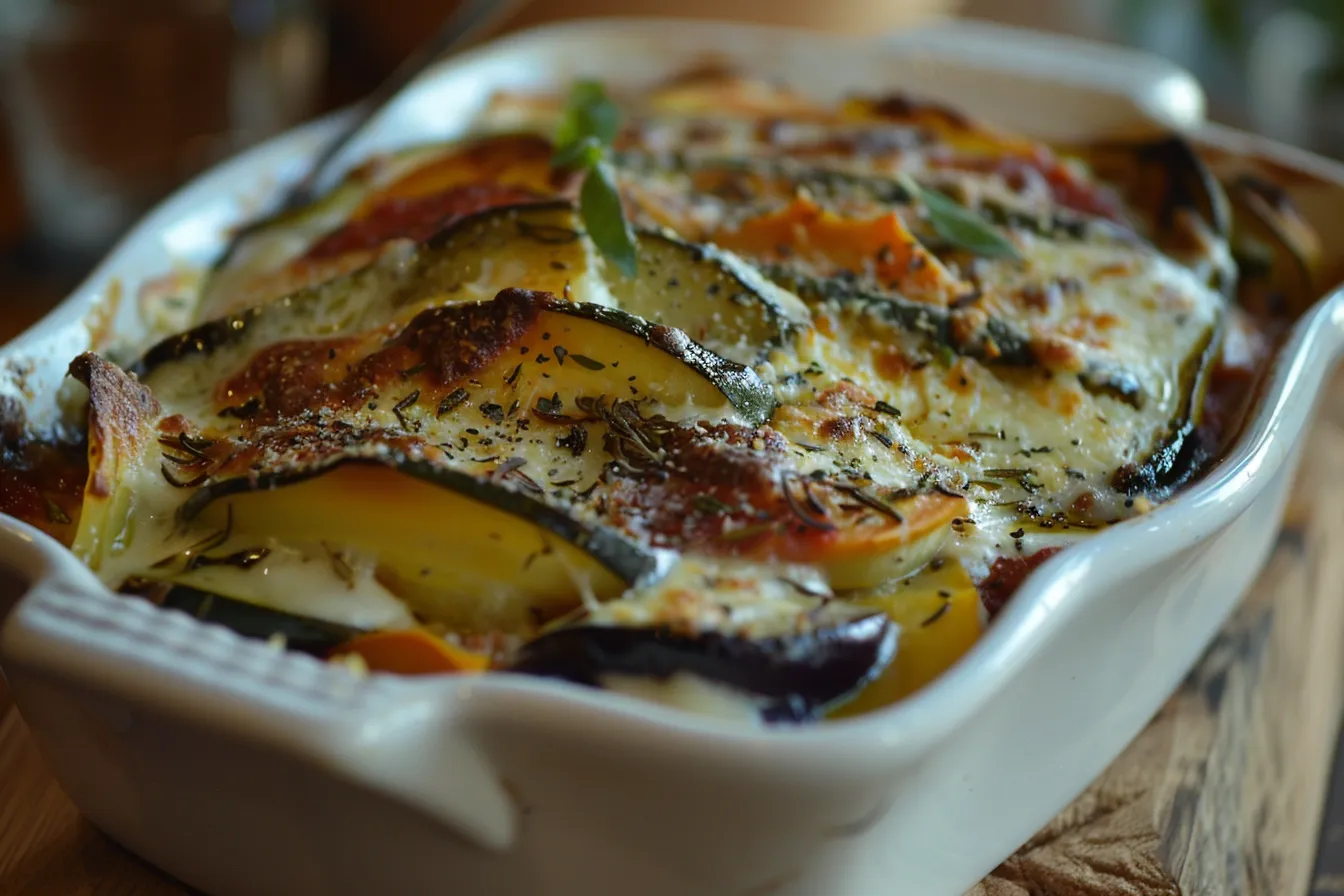
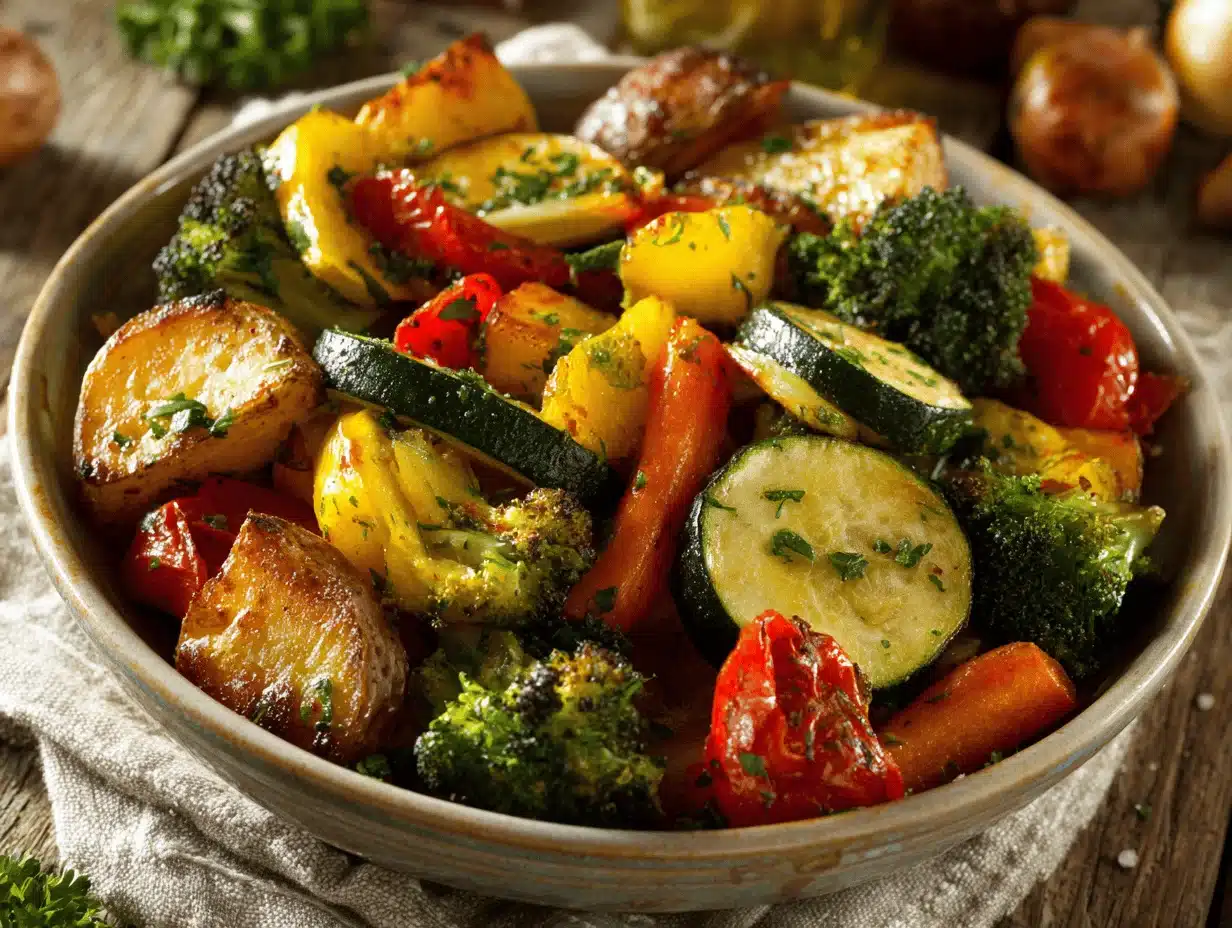
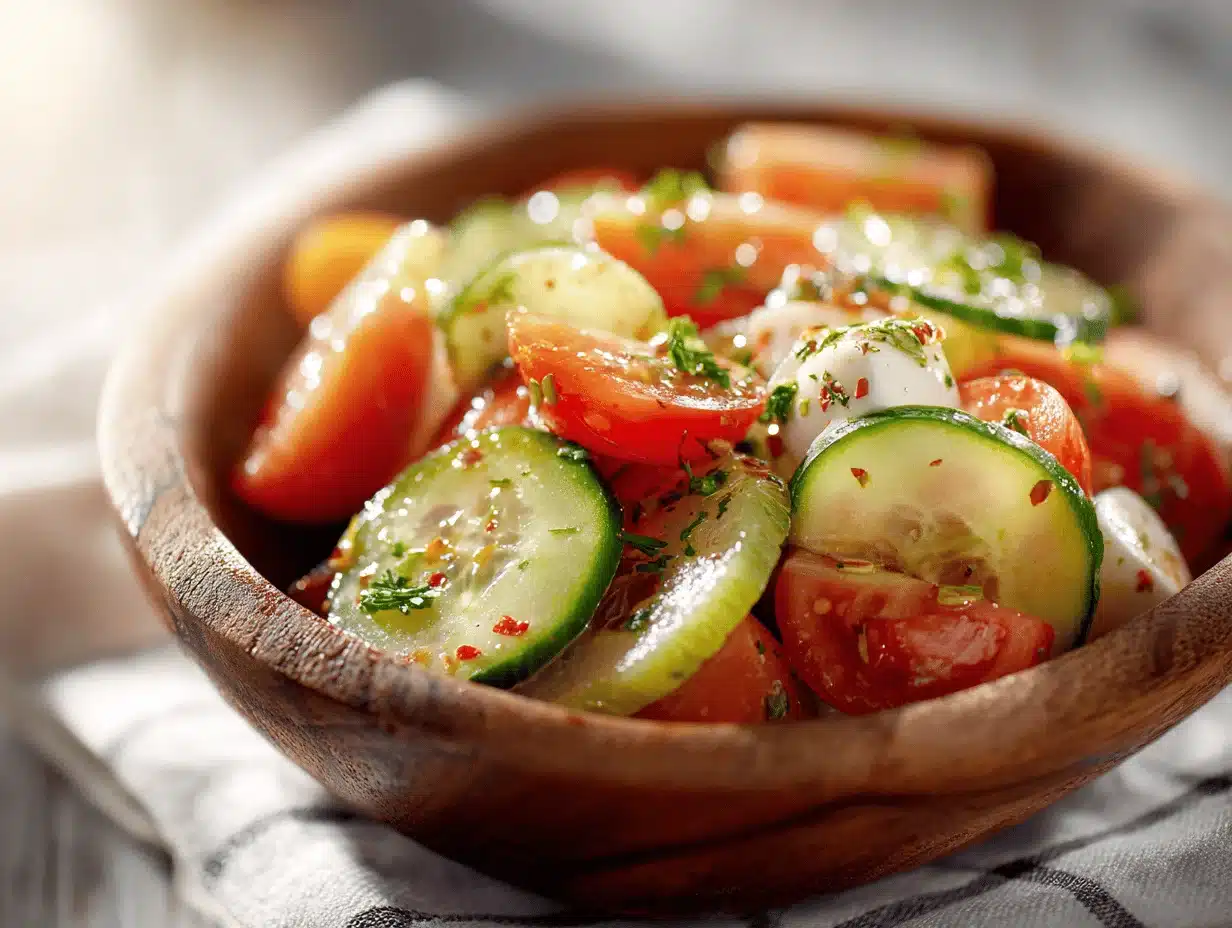







2 thoughts on “Vegetable Lasagna – A Cheesy and Healthy Comfort Dish”